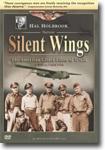| |
|
 
|
SILENT WINGS - THE AMERICAN GLIDER PILOTS OF WWII |
 |
 |
| Narration/featuring: Hal Holbrook; Andy Rooney, Walter Cronkite |
| Director: Robert Child |
|
Studio: Inecom Entertainment |
| DVD release: 20 March 2007 |
|
Runtime: 113 minutes (1 disc) |
| Format: Black & White, Closed-captioned, Color, Dolby, DVD-Video, NTSC, Surround Sound |
| DVD Features: Languages (English), Audio (Dolby Digital 2.0; Dolby Digital 5.1 Surround Sound;
DTS 5.1 Surround Sound; Stereo), Virtual walkthrough tour of the Silent
Wings Museum in Lubbock TX, Interview with Robert Child about the
project and putting the film together, Trailers |
|
Robert Child's Silent Wings - The American Glider Pilots of WWII opens a door on a lesser-known piece of World War II history: that of the un- powered, un-armored gliders used in the Second World War to carry troops and equipment into battle. As a WWII buff of sorts, I'd heard of them but never had a good understanding of what they did and why in the world they'd do it without engines. Silent Wings opens a door on a lesser-known piece of World War II history: that of the un- powered, un-armored gliders used in the Second World War to carry troops and equipment into battle. As a WWII buff of sorts, I'd heard of them but never had a good understanding of what they did and why in the world they'd do it without engines. Silent Wings gives us the origins of the U.S. military's glider program and details our reasons for using this disposable technology. That's right, disposable. They were towed to their targets, or at least near the targets, and left to glide to the ground. The US spent around $15,000 each on these items, trained those crazy enough (by their own admission) to fly them and left them on the battlefield. The pilots then became infantry and rushed into battle like any other foot soldier. gives us the origins of the U.S. military's glider program and details our reasons for using this disposable technology. That's right, disposable. They were towed to their targets, or at least near the targets, and left to glide to the ground. The US spent around $15,000 each on these items, trained those crazy enough (by their own admission) to fly them and left them on the battlefield. The pilots then became infantry and rushed into battle like any other foot soldier.
Silent Wings brings us interviews with pilots, passengers, and experts in the field. We hear wonderful and touching stories from Andy Rooney and Walter Cronkite about their experiences in gliders. Cronkite actually carried a typewriter and paper into the fray as a civilian reporter. He said that the gliders, from within, were anything but silent. He also recounts an amusing anecdote about the time he led troops to a rendezvous point from the landing site. brings us interviews with pilots, passengers, and experts in the field. We hear wonderful and touching stories from Andy Rooney and Walter Cronkite about their experiences in gliders. Cronkite actually carried a typewriter and paper into the fray as a civilian reporter. He said that the gliders, from within, were anything but silent. He also recounts an amusing anecdote about the time he led troops to a rendezvous point from the landing site.
The gliders were not easily accepted by the war department, especially after a public exhibition went horribly wrong. This put the glider program on tenuous ground, and so they seemed to stay for most of their existence. But no one can deny the bravery of those men who flew the gliders, nor the benefit to the war effort the program brought.
Those who piloted gliders in the Second World War will not be forgotten, but illuminated, celebrated by this film. Well done.
|
|
|



